Videos

July 3, 2023 | Daily JAM, Videos |
Today’s Trend of the Week is U.S. Economy Last Man Standing. The U.S. economy is moving along at a surprisingly positive rate given the Fed’s repeated rate increases. Earlier in the year I expected a summer recession, but that no longer appears to be the case. We may see a recession later in the year, but as of now, the U.S. economy hasn’t dropped into a negative quarter–and the U.S. economy looks like the strongest in the world. Which my not be saying much. China is growing faster by the official numbers, but it needs to maintain at least a 5% growth rate to keep up with population growth. At the moment, with 4% growth, China’s unemployment rate for 16-24 year-olds is over 20%. This has led to country-wide dips in consumerism and has hammered the overall economy. We’re now seeing a slowdown in the EuroZone. The European Central Bank announced that they’re still seeing 6% inflation and raised interest rates by another 25 basis points. This policy is likely continue as the central bank tries to reach a 2% inflation rate. Growth in the EuroZone has been down for the last five months, and hit a new low in June. The Purchasing Managers Index (PMI) fell to 50.3. 50 is considered the break points between contraction and expansion. There’s a good possibility that the second quarter could be negative for the Eurozone, bringing the bloc closer to a recession. With China and the eurozone flailing economically, the U.S. economy is the last man standing.
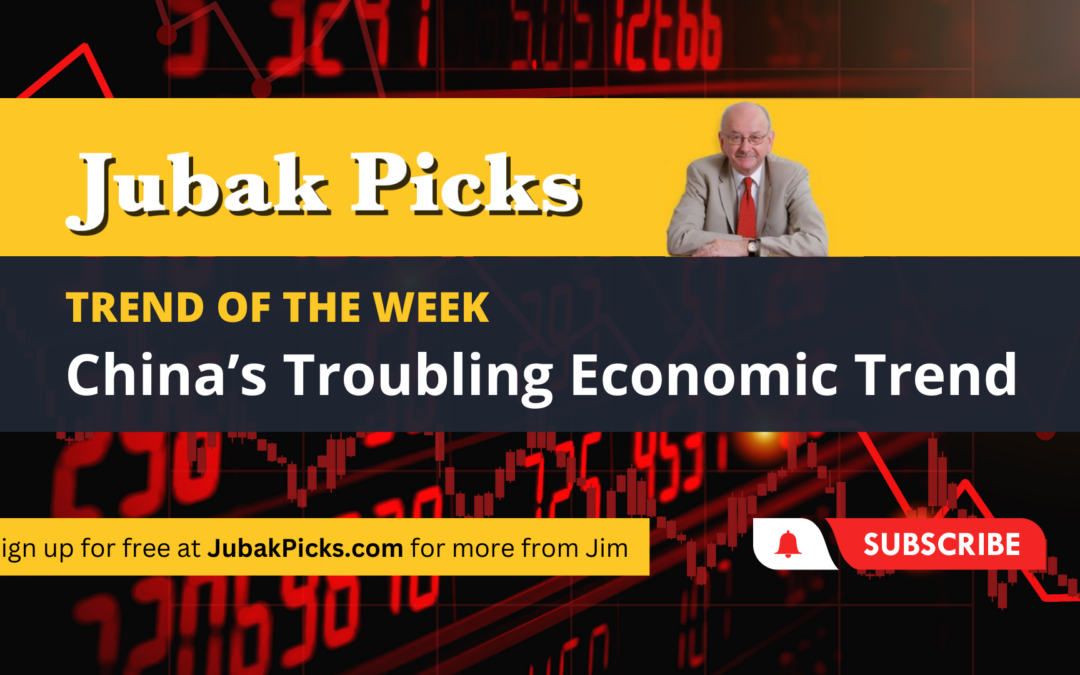
June 26, 2023 | Daily JAM, Long Term, Videos |
Today’s Trend of the Week is China’s Troubling Economic Trend. This graduation season is highlighting the economic problems China is facing. The 16-24-year-old Chinese demographic went to college as a way of delaying entering the job market during COVID, with the expectation of a guaranteed job upon graduating. The bad news is those jobs have not materialized. Unemployment for the 16-24 year age group was up to 20.8% in May, even higher than April’s shocking number. These Chinese college graduates have recognized this problem and have started a movement called “lying flat.” These potential consumers, they say, will not be buying houses, or cars but instead, will cut consumption. This negative view of the future trend in the economy has spread to all demographics and has led to people hoarding cash. The People’s Bank of China has cut short-term interest rates and the state council has suggested another stimulus package is coming. These factors could give Chinese stocks a bump up, but won’t get to the heart of the economic problem or bring the country’s growth above 5%. I’ve switched my international diversification to South Korea from China on JubakAM.com because I believe this economic trend is a long-term issue and that these problems are deeply embedded in the Chinese economy.

June 21, 2023 | Daily JAM, Videos |
Inflation deserves a bigger role in your portfolio. This vase of peonies reminds me of my first summer job: picking Japanese beetles off of my uncle’s peonies. He would offer what sounds like a not-so-generous salary of 25 cents per jar of dead beetles. But remember that’s 25 cents in 1960 or so. In thinking about inflation, I researched how much 25 cents in 1960 would be equivalent to today. 25 cents in 1960 amounts to $2.53 a jar. Still not terribly generous, but better. $100 in 1960 would be worth $1009 today, a ten-fold increase due to inflation. The Fed is still at work to stem inflation, but investors should note that there are some prices that the central bank can’t control. Inflation is built into the global climate economy with disruptions in agriculture, and new kinds of energy production (which will require higher costs), supply chain issues, not to mention that climate change is making some previously habitable places uninhabitable. All these problems will lead to extraordinary sources of inflation that are not susceptible to central bank policies. In order to hedge that inflation, make sure your portfolio, especially if it’s a long-term portfolio, has positions in things like gold or copper and lithium which will be in high demand and short supply in the next decade (at least.)
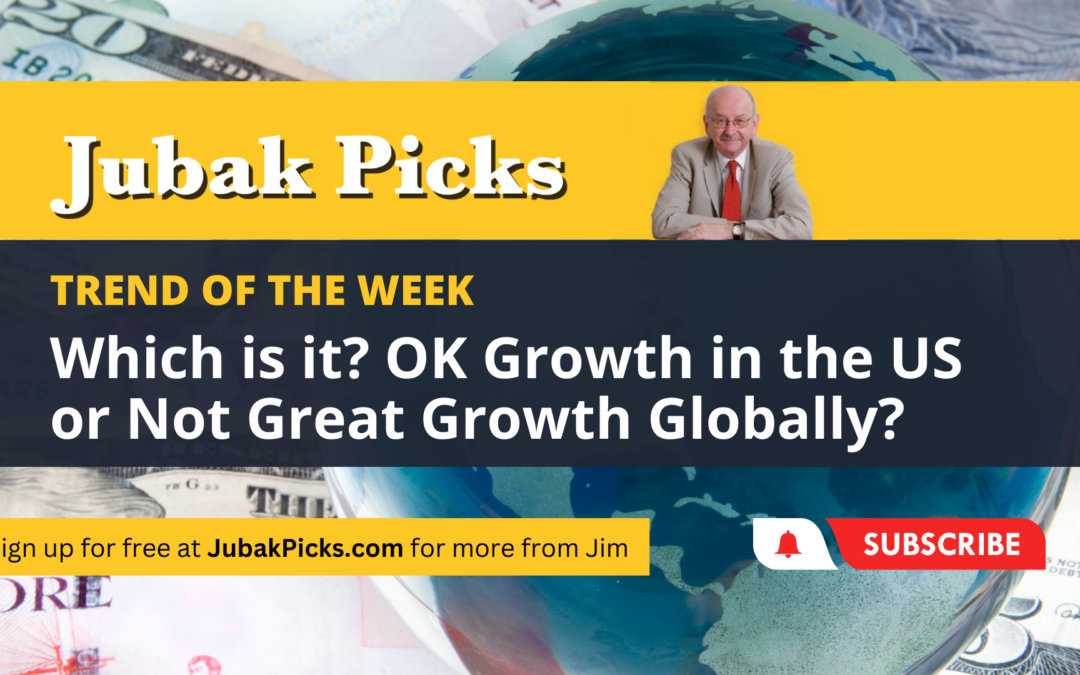
June 20, 2023 | Daily JAM, Dividend Income, DVN, PXD, Videos |
Today’s Trend of the Week is Which is it? OK Growth in the U.S. or Not Great Growth Globally? The U.S. market is rallying and the rally even expand from the narrow nine stocks that have been driving up the indexes. The consensus is the U.S. economy will avoid a recession, the Fed will continue to pause rate hikes, and the U.S. economy as a whole is in decent shape. The problem is that the global economy presents a completely different story with asset values pricing in slowing growth. This shows up most clearly in oil prices, which have been in a downward trend. On June 13, West Texas Intermediate was selling below $70 a barrel, and Brent was down to 74.57. Goldman Sachs has cut its end-of-the-year oil price forecast by about 10%. This cut assumes continued lower demand from China and a supply glut, especially from Russia, as that country produces above agreed-upon caps in an effort to fund its war in Ukraine. If you own oil stocks right now, confirm that the ones in your portfolio can continue to make money at $70 a barrel (at least enough to cover dividends). I’d note the lowest cost source in the United States is in the Permian Basin. Companies like Pioneer National Resources and Devon Energy are focused on production from that region.

June 19, 2023 | Daily JAM, Dividend Income, NEE, Videos |
This week’s Quick Pick is utility NextEra Energy (NEE). NextEra is focused on Florida, a state with a relatively utility-friendly regulatory scheme, and where the company’s Florida Power and Light has 5.8 million customers. NextEra operates a mix of energy sources including seven nuclear plants, 4.6 gigawatts of solar, and, recently, hydrogen as well. That’s a good mix, fortunately, or unfortunately, for this point in the climate crisis. I have owned NEE since November 2020 in my dividend portfolio. The stock price hasn’t moved a lot lately, but if the Fed continues its pause on rate hikes and the economy doesn’t slow further, I think this one will outperform. Right now you get a 2.5% dividend with the possibility of capital appreciation if the company’s alternative energy efforts continue to show growth and when/if the Fed cuts interest rates.
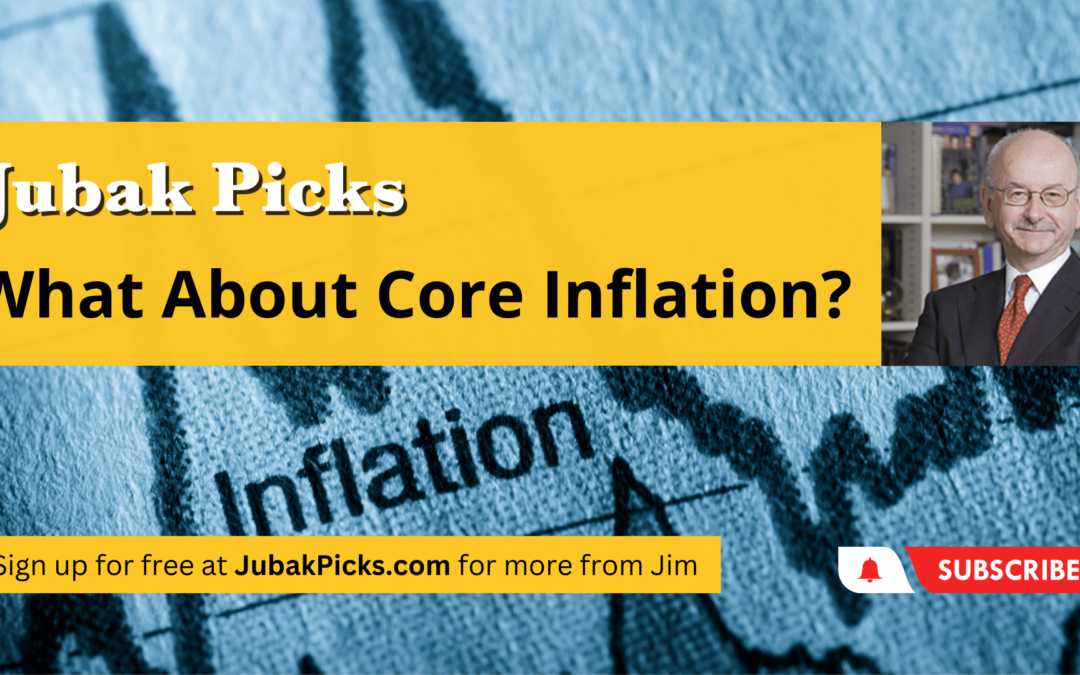
June 17, 2023 | Daily JAM, Videos |
What about core inflation? The most recent CPI numbers have been cause for market celebration. For example, here was the headline on Bloomberg: “US Inflation Slows, Giving Room for Fed to Pause Rate Hikes.” But the excitement comes from a focus solely on the headline inflation or the all-items index. The Fed, however, generally bases its decisions on core inflation, which removes energy and food prices from the equation. All item inflation dropped to a 4% annual rate in May, down from 4.9% in April, and was up just .1% month to month. This is great news for consumers as prices start to come down. The bad news is that core inflation is still pretty high, with the May annual rate at 5.3%, above economists’ hopes for 5.2%, and up .4% month to month. One of the main differences in the rate of core and all item numbers is energy. Oil prices around the world are dropping and that’s driving the decrease in the all-items inflation number. The Fed has little control over energy and food prices, which is why its decisions are generally based on core inflation. While the Fed paused rate hikes in June, those increases may not be over if core inflation continues to disappoint.
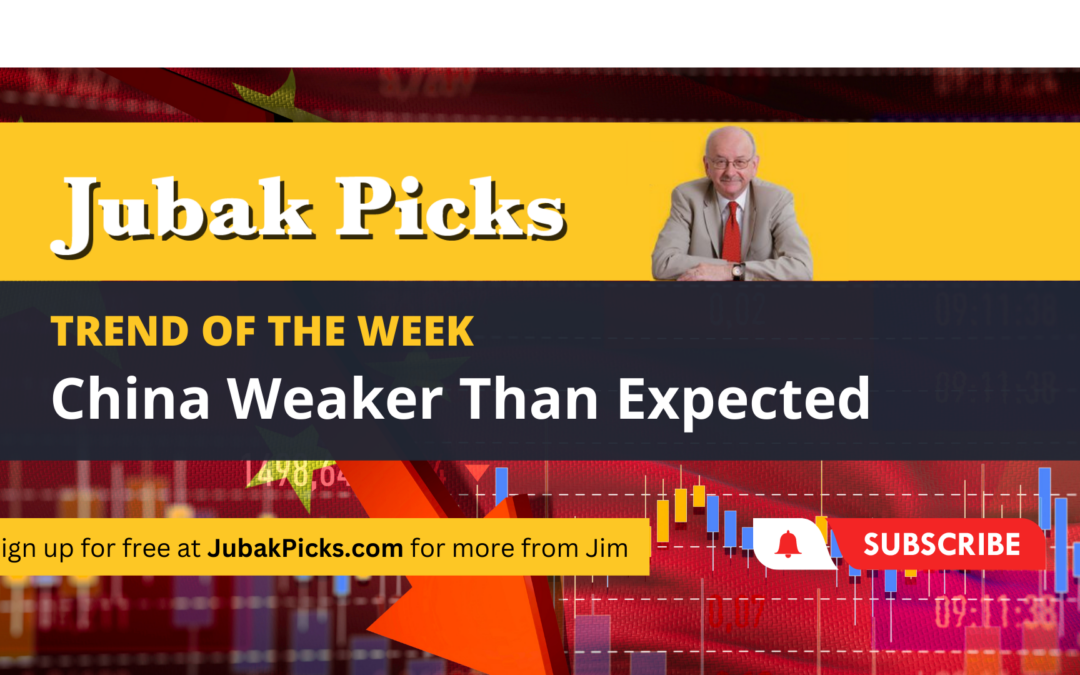
June 15, 2023 | Daily JAM, Videos |
Today’s Trend of the Week is China Weaker Than Expected. The key part here is “than expected.” In the most recent official government report, Chinese exports were down 7.5% year over year. Economists were expecting a much more modest drop of 0.4%. The semi-annual projections from the World Bank and the OECD (Organization for Economic Cooperation and Development) predicted a slowing for the global economy, but still a relatively positive outlook. However, those projections were based on solid growth from China, which the latest official figures suggest is certainly not a done deal. The World Bank and OECD reports imply that if China’s growth disappoints, world economic growth projections of 1%-2% will be high. At this point, the global economy is leveraged to Chinese economic growth, so if China doesn’t do well, that spreads throughout the world. Low-income countries that cannot pay their debts and are facing higher interest rates are sounding the alarm that they may soon be unable to feed their people. A slowing global economy would essentially amount to a run on low-income countries, which could spread to the rest of the economy. This is a trend to keep an eye on and a good time to make sure your investments are in dollar-denominated assets. (Not that the dollar is in such great shape.)

June 14, 2023 | Daily JAM, Videos |
Today’s Quick Pick is 2 Year Treasuries Follow-Up. In my last Quick Pick, I said that if the Two-Year Treasury yield got up over 4.5, it’d be a good time to buy. Well, on June 6, the yield on the Two Year Treasury hit 4.58, up 68 basis points in one month. There is still a lot of issuance to come, so you may want to go in at half now and half a little later. From June 2-June 13, the Treasury increased the supply of Treasury Bonds by $131 billion in an effort to rebuild its cash position. They’ll continue to issue more bonds through July to meet their goal of $500 billion. The peak here would be sometime in the next few weeks or in July. The reason to buy the Two Year is it’s very sensitive to the Fed and economic changes. You can get a CD with a 5% yield, but the CD won’t earn you capital appreciation. If rates go down when the Fed stops raising rates, treasury yields may go down, but the bond will go up. Right now, be looking for that peak yield, possibly 4.6 in the coming days and weeks. (After the June 14 Fed meeting the yield on the 2-year Treasury rose to 4.69%, I’d note. Looks good to me here for a half position.)
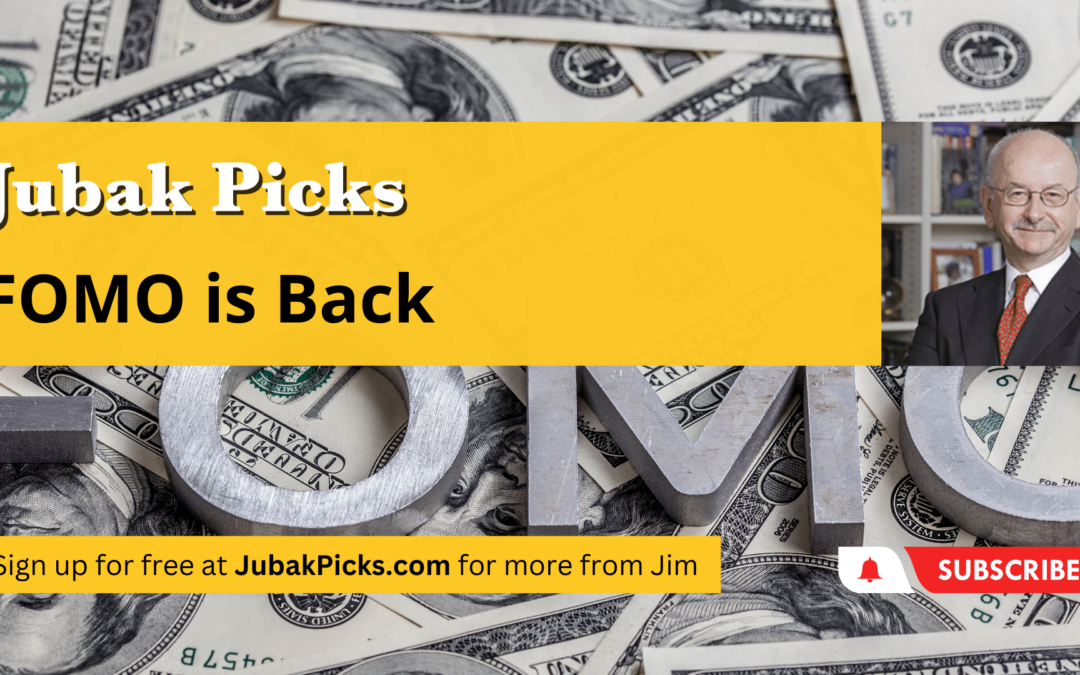
June 14, 2023 | Daily JAM, Videos |
FOMO is back. FOMO (or, fear of missing out), sweeps over the market every so often. And it’s certainly been familiar in the last year or more. Portfolios and investors buy stocks because they’re going up and they don’t want to miss out, even if the stock’s valuation doesn’t really make much sense. Apple recently announced its new VR headset, priced at $3,500 while the competition is closer to $350. The new technology is impressive but whether or not there is a market for this high-priced item is unclear. Kim Forrest, from Bokeh Capital, commented on Bloomberg that “Apple’s valuation hasn’t been compelling for years. You buy it because it mints cash and the gravitational pull of it in the index makes you need to own it to keep up with the markets.” Essentially she says, I don’t like it, but I need it or I’ll miss out on one of the main stocks propping up the S&P 500 at the moment. I’ve talked about the narrow market before and this is another example of core technology companies propping up a sideways market. Investors are flocking to stocks like Apple so they don’t miss out on gains, even though the air between the valuation and price continues to increase. The worry is that FOMO can collapse very suddenly when investors decide they’re no longer willing to pay the high price or we hit a recession.

June 6, 2023 | Daily JAM, NVDA, Videos |
Today’s Trend of the Week is Should You Sell Nvidia? Nvidia (NVDA) has had a great run. Recently, post-earnings, the stock shot up even higher It’s up 44% in the last month, 67% in the last three months, and 166% year to date. The PE on trailing earnings is 203. (The average market PE for a well-liked growth stock is closer to 25-28.) That makes this an making this extraordinarily high-priced stock. However, the forward PE is “just” 84 times projected earnings per share over the next 12 months. That’s below very hefty projected earnings growth. The current growth projection for the second quarter is at 302%; the following quarter is 286%; and for the year as a whole, 132%. So at 84 times projected earnings this isn’t extraordinarily expensive–as long as those projections come through. It’s very hard for a company, even Nvidia, to maintain this kind of growth for very long. Growth in 2024 is only projected at 34%. If we get down to 50% or 30% growth, the market is likely to wake up one day and feel this is a really expensive stock. So keep an eye on guidance for 2024 as we get closer to 2024. (A rule of thumb is that Wall Street analysts tend to look about 6 months ahead in their buy/sell/hol calls on a stock. For now, hold on. Until you see growth projections start to drop below 100%. At that point, even if a stock growing by 50% a year is an amazing future story, a door might be a good thing to find.

June 5, 2023 | Daily JAM, Videos |
Today’s Quick Pick is 2 Year Treasuries. Ten-year Treasuries with a 5% yield may still be a long way out, but Two-year Treasuries now have a yield of 4.5%. Rates may continue to go up in the short-term and the Fed is likely going to raise interest rates again in June or July, but this is a good place to start a position in these Treasuries. You can, of course, get a CD with a 5% yield, but the CD won’t earn you capital appreciation. If rates go down when the Fed stops raising rates, treasury yields may go down, but the bond may go up. We’ll likely see a peak in rates in the third quarter, so at the moment, I think Two-year Treasuries are a good buy.
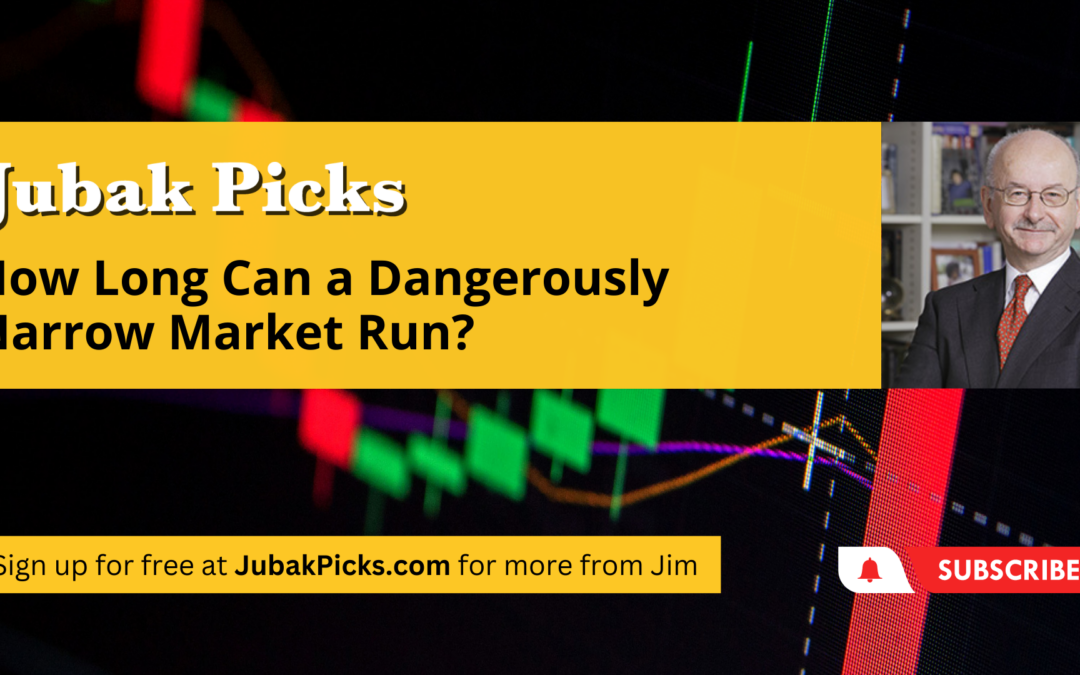
June 3, 2023 | Daily JAM, Videos |
How Long Can a Dangerously Narrow Market Run? Certainly not forever. But longer than you might imagine. The Nasdaq 100 and S&P 500 have increasingly diverged. The week before last, the NASDAQ 100 (which includes the largest technology companies), was up 3.15% and the S&P was up only .28%. Over the last three months, the NASDAQ 100 was up 18.88% and the S&P was up 6.14%. For 2023 to date through May 29, the NASDAQ was up 31%, and the S&P was up 10%. NASDAQ tech stocks, like Nvidia (NVDA), are driving the index up and that is pulling the rest of the market with it. The remainder of the market, however, is weighed down by warnings of a tough retail economy, companies reporting negative growth, and inflation problems. At the moment, investors are betting on technology’s big growth to avoid problems from a slowing economy, prolonged high inflation, and the Fed’s rate hikes. The result is a very narrow market, with a small number of specific stocks propping it up. History says, that eventually, the market rally will either expand, with more stocks participating, or it will fail because you can’t sustain an upward trend with fewer and fewer stocks. Narrow markets can run for longer than you might think. But it’s not too early to locate the exits.















